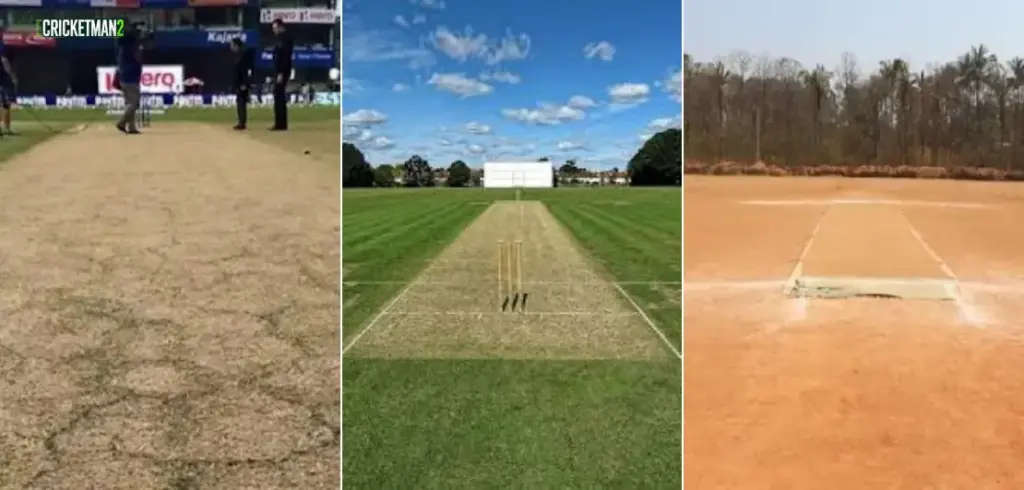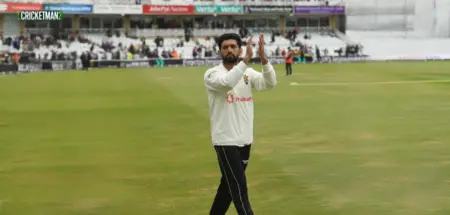Cricket is not just about bat and ball — it’s equally about the surface on which the game is played. The pitch plays a vital role in deciding how a match unfolds, whether it becomes a high-scoring contest or a low-scoring thriller. The behavior of the ball — bounce, swing, and turn — all depend on the type of cricket pitch.
In this detailed article, let’s understand the types of cricket pitches, how they are prepared, and how they differ across various countries.
Types of Pitches in Cricket
| Type | Ideal For | Found In | Key Feature |
|---|---|---|---|
| Green | Fast Bowlers | England, NZ, SA | Swing & Seam |
| Dusty | Spinners | India, SL | Turn & Grip |
| Flat | Batsmen | ODIs, T20s | High Runs |
| Dead | Batsmen | Subcontinent | No Movement |
| Dry/Hard | Balanced | Australia, India | Bounce & Reverse Swing |
| Wet | Swing Bowlers | Rainy Regions | Unpredictable Bounce |
You Can Read Also:- Lunch Break Time in Test Cricket
What Is a Cricket Pitch?
A cricket pitch is the central rectangular area of the ground between the two wickets. It measures 22 yards (20.12 meters) in length and 10 feet (3.05 meters) in width. The pitch is usually flat and covered with short grass, but its texture and moisture vary depending on soil type, climate, and preparation.
| Measurement Type | Length | Width |
|---|---|---|
| In Yards | 22 yards | 3.33 yards |
| In Meters | 20.12 m | 3.05 m |
| In Feet | 66 feet | 10 feet |
The condition of the pitch is often the deciding factor in a game — favoring either batsmen or bowlers.
How Is a Cricket Pitch Made?
The process of making a pitch is technical and requires skilled ground staff:
- Soil Preparation: The soil is cleaned, leveled, and compacted with rollers.
- Layering: Several layers of clay and loam soil are added for firmness and bounce.
- Rolling and Watering: Regular rolling gives smoothness, while watering maintains moisture balance.
- Mowing: Grass is trimmed to control pace and bounce.
- Covering: Covers protect the pitch from rain and dew.
Proper maintenance — including sweeping, mowing, and rolling before each day’s play — keeps the surface consistent.
Factors Affecting Pitch Behavior
- Moisture: More moisture helps seam and swing bowlers.
- Grass Cover: Green grass increases movement for pacers.
- Heat & Dryness: Dry surfaces aid spin and rough patches.
- Cracks: As the match progresses, cracks appear, helping spinners on later days.
Types of Cricket Pitches
Cricket pitches are broadly categorized into six types based on surface nature, moisture, and preparation.
| Pitch Type | Best Suited For | Characteristics |
|---|---|---|
| Green Pitch | Fast Bowlers | Moist, grassy, helps swing and seam movement |
| Dry/Hard Pitch | Batsmen & Spinners | No moisture, true bounce, later helps reverse swing |
| Dusty Pitch | Spinners | Soft and dusty, allows turn and grip |
| Flat Pitch | Batsmen | Even bounce, no movement, high-scoring |
| Dead Pitch | Batsmen | No grass or cracks, no help for bowlers |
| Wet Pitch | Swing Bowlers | High moisture, unpredictable bounce |
Let’s understand them in detail.
Read Also:- Tea Break Time in Test Cricket
1. Green Pitch – Paradise for Fast Bowlers
A green pitch is covered with fresh grass and contains high moisture. The grass allows the ball to seam and swing, especially during the early overs.
- Found in: England, New Zealand, South Africa
- Favours: Pace bowlers
- Difficulty: Batting becomes challenging as the ball moves both in the air and off the surface.
Example: Lord’s and Old Trafford in England are known for their classic green tops.
2. Dusty Pitch – Spinner’s Dream Surface
A dusty pitch is soft and contains loose, dry soil. It provides excellent grip to spinners, making the ball turn sharply.
- Found in: India, Sri Lanka, Bangladesh
- Favours: Spin bowlers
- Challenge: Predictable bounce but dangerous for unprepared batters.
Fun Fact: Most Indian grounds like Chepauk (Chennai) and Eden Gardens (Kolkata) are known for their spin-friendly dusty pitches.
3. Flat Pitch – The Batter’s Delight
A flat pitch has minimal grass, consistent bounce, and no cracks. It offers nothing for the bowlers, turning matches into run-fests.
- Found in: Limited-overs matches (ODIs, T20Is)
- Favours: Batsmen
- Challenge: Bowlers struggle for wickets unless they rely on variations.
Example: The Wankhede Stadium in Mumbai and Adelaide Oval in Australia are known for flat surfaces.
4. Dead Pitch – High Scoring, Low Drama
A dead pitch is an extremely flat and dry surface with no grass or moisture. It provides true bounce and no movement. Bowlers find it tough to get breakthroughs, making it ideal for ODIs and T20s.
- Found in: Subcontinental limited-over venues
- Favours: Batsmen
- Challenge: Minimal help for both pace and spin bowlers.
Interesting Insight: Dead pitches often lead to record-breaking totals — perfect for white-ball cricket entertainment
5. Dry and Hard Pitch – Balanced for All
A dry and hard pitch is firm and bouncy but lacks moisture. It starts as a batting-friendly surface but gradually wears down, bringing spinners into play on later days.
- Found in: Australia, South Africa, parts of India
- Favours: Fast bowlers initially, spinners later
- Advantage: Offers true bounce, ideal for Test cricket.
6. Wet Pitch – Unpredictable and Tricky
A wet pitch has high moisture due to rain or dew. The ball skids and behaves unpredictably, making batting tough.
- Found in: Rain-prone regions
- Favours: Swing bowlers
- Challenge: Slippery surface affects both bowling grip and fielder movement.
Pitch Conditions Around the World
| Country | Pitch Type | Traits |
|---|---|---|
| India | Dry, Dusty | Spin-friendly, helps turn and reverse swing |
| Australia | Hard, Bouncy | Assists fast bowlers, true bounce |
| England | Green, Moist | Ideal for swing and seam |
| South Africa | Hard, Fast | Bounce with seam movement |
| New Zealand | Green, Windy | Movement due to air and grass |
| Pakistan | Flat, Dry | High scoring, supports spin |
| West Indies | Balanced | True bounce, moderate pace |
| Sri Lanka | Dusty, Humid | Spin and reverse swing friendly |
| Bangladesh | Slow, Damp | Low bounce, ideal for spin |
| UAE | Dry, Flat | Favorable for batting, helps spin late in game |
Qualities of a Good Pitch
A good cricket pitch ensures balance between bat and ball. It must have:
- Consistent Bounce: Predictable movement off the surface.
- Durability: Withstands five-day matches.
- Safety: No unpredictable bounce or dangerous cracks.
- Fairness: Offers help for both pacers and spinners at some stage.
Read Also:- How to Calculate Follow on in Test Cricket
Conclusion
Understanding cricket pitch types is key to appreciating the strategy behind every match. Whether it’s the grassy swing of Lord’s, the turning dust bowls of Chennai, or the lightning pace of Perth — the pitch defines the contest.




